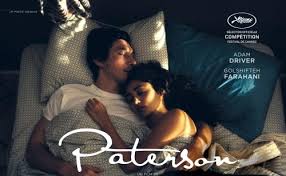Paterson

In her January, 2015, New York Times article Writing Your Way To Happiness, Tara-Parker Pope cites a plethora of research demonstrating that the act of writing can improve mood disorders, reduce depression, and even improve outcomes for cancer patients. Journaling is among the therapeutic writing strategies discussed, and journaling is a long-standing tool encouraged by therapists to accompany therapy.
Therapeutic journaling strategies vary. Some therapy clients are encouraged to use a journal to track thoughts, feelings and behaviors. Some prefer to journal in the more traditional sense, as a personal diary and a means to describe personal daily experiences and memories, and to identify and express internal feelings. In Jim Jarmusch’s off-beat, lyrical film Paterson, the therapeutic mechanism is poetry.
Paterson (Adam Driver) is a New Jersey Transit bus driver who punctuates his otherwise predictable days writing unexpected, glorious poetry in his private notebook. He tells his adoring girlfriend that he is writing a poem about her. When she asks if it is a love poem, he matter-of-factly explains that because it is about her, it is certainly a love poem. This simple exchange is a metaphor for the film itself, which functions as a love letter to the art of poetry.
Paterson writes about love, objects and nature with simple, quiet irony. He is, after all, a bus driver named Paterson, whose route circulates the town of Paterson, New Jersey.
The film’s plot is less of a formal story line and more of a poem. Random moments and meaningful ones are interspersed with words from Paterson’s notebook scrolling along the side of the screen. In one of the most memorable moments of this utterly whimsical but serious film, Paterson stumbles upon a young girl in an alley by the bus depot. The street does not look particularly safe, and she looks too young and too innocent to be sitting on a dumpster, unaccompanied. Paterson asks if he can sit with her until her mother returns. It turns out that she, too, possesses a cherished notebook filled with with poems. They bond quickly over a love for poems in general and Emily Dickinson in particular. She reads him her favorite of her own poems:
Water Falls. Water falls from the bright air, it falls like hair, falling across a young girl’s shoulders. Water falls, making pools in the asphalt, dirty mirrors with clouds and buildings inside. It falls on the roof of my house, it falls on my mother and on my hair. Most people call it rain.
The poems in Paterson were written by Jarmusch’s friend, the poet Ron Padgett, who wrote four original poems for the film.
The film closes with another chance encounter with a fellow poet. Paterson has suffered a loss, and seeks solace in his favorite spot, a local waterfall referenced in his favorite poem “Paterson” by William Carlos Williams. A stranger (played Japanese poet Masatoshi Nagase who is perhaps playing himself) approaches and — like the young girl in the alley — they bond through poetry. Poetry is everywhere, in the mundane, the erotic, the outdoors and the urban streets. Whether writing for others, or writing for ourselves, the understated beauty of this magnificent film celebrates poetry, writing, and magic of human connections.
Note to Jarmusch fans — the poet Masatoshi Nagase was also featured in the epic and unforgettable Jarmush classic, Mystery Train!
